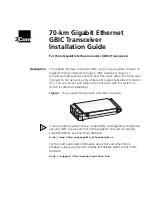
Guidelines for Channel/Frequency Configuration
7 Troubleshooting
69
Broadband Interference
A broadband interference source occupies the bandwidth of many channels causing degradation of the
carrier-to-noise ratio (CNR) on all of the telemetry channels for as long as it is present. This results in an
increase in dropouts on all of the channels. The system has quiet and noisy periods. When the noise source
is on, the system is noisy. When the noise source is off, the system performs well. To try to eliminate the
problem:
• Troubleshoot the problem as it is occurring. Use the Service Support Tool to scan the RF environment
for interference (refer to the
Service Support Tool Help
for details). Ask users to determine if there is a
pattern, when the episodes occur, and how long they last. If there is a pattern (for example, every
morning between 6 and 8 AM), try to predict when it will happen again, and prepare to troubleshoot.
• Locate where the interference signal is entering the system. If an antenna system is being used, remove
branches from the antenna system to see when the interference quiets down. Remember that you will
not be able to monitor patients that are being received by antennas that have been removed.
• Remember that interference sources can move, making troubleshooting a little more difficult. Work
quickly!
• Solve the problem by trying to eliminate or repair the source. In the case of an antenna system, relocate
or permanently remove the antenna where the signal is entering. Things to check for that cause
broadband RF interference are other pieces of electrical equipment, especially RF devices using the same
frequency range.
Guidelines for Channel/Frequency Configuration
1
Where there is no significant RF interference, no other telemetry devices and a small number of Avalon
CTS systems (ten or less) are installed, then the standard configuration with automatic free channel
search should be used.
2
If interference from other RF sources is encountered, then it may be appropriate to still use automatic
free channel search, but excluding the offending frequencies (see “Excluding Frequencies” below), using
the Service Support Tool.
3
If there are many telemetry devices and/or multiple Avalon CTS installations in the hospital, we
recommend that an RF plan is implemented, with different frequency ranges allocated to different types
of telemetry. In this case, the base station should be set to fixed frequency operation (see “Base Station
with Fixed Frequency” on page 70), in conjunction with excluded frequency ranges.
4
If there are only a small number of available frequency channels, consider using fixed frequency
transducers (see “Transducers with Fixed Frequency” on page 71). If dedicated frequencies are required,
use fixed frequency transducers.
Scanning the Available Frequency Range
If interference is evident or suspected the first step is to use the Service Support Tool to perform a scan of
the available frequency range to identify interferers and locate occupied frequency ranges. This informs you
which frequencies you may need to exclude. To do this you need:
• An industry standard PC with the Service Support Tool software installed (you can find this on the
supplied Fetal Monitoring Documentation DVD-ROM)
• PC interface cable for the Service Support Tool (M1360-61675)
Summary of Contents for Avalon CTS M2720A
Page 2: ...ii ...
Page 32: ...3 System Interfaces Compatible Fetal Monitors 26 ...
Page 66: ...6 Preventive Maintenance and Safety Battery Exchange 60 ...
Page 92: ...9 Upgrades 86 ...
Page 102: ...10 Specifications Essential Performance 96 ...
Page 104: ...A Removing and Replacing the Transducer Battery 98 Wipe off excess silicone grease ...
Page 108: ...C Avalon CTS Frequency Table 102 ...
















































